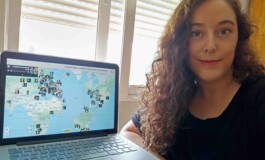


1 September 2021
From Kassia, a Byzantine nun born in 810, to Alma Deutscher, a 16-year-old English young lady: Sakira Ventura has created an interactive world map that lists and geographically locates 530 forgotten women composers. The young Spanish music teacher wanted to give them back the place they deserved in history. Among these women composers is Pauline García Viardot, whose bicentennial is being celebrated in 2021. She is one of the twenty or so women composers listed in France, along with Claire Delbos, Mademoiselle Baumesnil, Claude Arrieu, Cécile Chaminade and Elsa Barraine. For each of them, a biography and links to listen to some of their works are available. The European Music Center interviewed Sakira Ventura.

The interactive world map of forgotten women composers gathers 530 personalities who have impacted the history of music.
How did the idea for this interactive map of women composers emerge?
During the state of emergency due to COVID-19, I had enough free time to work on researching women composers in music history. I kept telling myself that I wanted to put these women composers on a map. So I decided to do it.
What were the criteria for selecting and highlighting these women creators on an interactive map?
That all these women be composers belonging to the classical or so-called learned music and to have recordings of their works. That to be able to propose it on their individual card. The goal of this project is to make it a pedagogical tool, and I wanted it to be a sound card, with life.
How do you explain the lack of visibility of women creators in the history of music?
The history of music has been written and narrated by men. As soon as they started to take an interest in researching this art, they focused their attention on everything that happened and was developed by men. Only they were allowed to play music in public. Women also participated actively in all musical disciplines, but for many centuries they did so confined within the walls of religious institutions or in their own homes. This was due to society's refusal to allow them to do so in public. This practice was far from the tasks that in theory they were supposed to assume as women. All this made them buried and invisible because of the patriarchal traditions. This is why a re-reading of the history of music has become indispensable to place them where they belong and with relevance. This is what they deserve.

Sakira Ventura, who created the interactive map, is a Spanish music teacher based in Valencia.
Some women composers, like Pauline Viardot, whose bicentennial is being celebrated this year, were recognized during their lifetime. Then, unlike men, they were forgotten after their death. How can this be explained?
Because of what I mentioned earlier: those who wrote the history of music focused all their attention on the activity of men. They have forgotten half of the world's population (women). Fortunately, more and more research is focusing on primary sources (newspapers, magazines, correspondence). These sources reveal what really happened and evoke the involvement of the people concerned in the musical development of a particular place at a given time. The case of Pauline Viardot is a clear example of this, and fortunately a great deal of work is being done to honor her personality and her work.
This mapping begins in the 9th century and goes on until 2005. Is there a golden age for women composers in history?
The 20th century I think, because it was a time when women could study almost normally within musical institutions and alongside their male colleagues. There were fewer obstacles for them to devote themselves professionally to music (which was unthinkable before). It was also during this period that most publications and recordings of women composers were made. So that's why most of my map focuses on this era.
Will you continue to develop this interactive map?
Yes, the map of women composers is a "work in progress" that I would like to complete progressively, as I have a very large database with half a thousand personalities still to be included. However, after the media coverage the project has received internationally, I will need some help or funding to allow me to continue my work (that's why I included a donation button on the platform).
Discover the interactive world map of forgotten women composers
1 September 2021
From Kassia, a Byzantine nun born in 810, to Alma Deutscher, a 16-year-old English young lady: Sakira Ventura has created an interactive world map that lists and geographically locates 530 forgotten women composers. The young Spanish music teacher wanted to give them back the place they deserved in history. Among these women composers is Pauline García Viardot, whose bicentennial is being celebrated in 2021. She is one of the twenty or so women composers listed in France, along with Claire Delbos, Mademoiselle Baumesnil, Claude Arrieu, Cécile Chaminade and Elsa Barraine. For each of them, a biography and links to listen to some of their works are available. The European Music Center interviewed Sakira Ventura.

The interactive world map of forgotten women composers gathers 530 personalities who have impacted the history of music.
How did the idea for this interactive map of women composers emerge?
During the state of emergency due to COVID-19, I had enough free time to work on researching women composers in music history. I kept telling myself that I wanted to put these women composers on a map. So I decided to do it.
What were the criteria for selecting and highlighting these women creators on an interactive map?
That all these women be composers belonging to the classical or so-called learned music and to have recordings of their works. That to be able to propose it on their individual card. The goal of this project is to make it a pedagogical tool, and I wanted it to be a sound card, with life.
How do you explain the lack of visibility of women creators in the history of music?
The history of music has been written and narrated by men. As soon as they started to take an interest in researching this art, they focused their attention on everything that happened and was developed by men. Only they were allowed to play music in public. Women also participated actively in all musical disciplines, but for many centuries they did so confined within the walls of religious institutions or in their own homes. This was due to society's refusal to allow them to do so in public. This practice was far from the tasks that in theory they were supposed to assume as women. All this made them buried and invisible because of the patriarchal traditions. This is why a re-reading of the history of music has become indispensable to place them where they belong and with relevance. This is what they deserve.

Sakira Ventura, who created the interactive map, is a Spanish music teacher based in Valencia.
Some women composers, like Pauline Viardot, whose bicentennial is being celebrated this year, were recognized during their lifetime. Then, unlike men, they were forgotten after their death. How can this be explained?
Because of what I mentioned earlier: those who wrote the history of music focused all their attention on the activity of men. They have forgotten half of the world's population (women). Fortunately, more and more research is focusing on primary sources (newspapers, magazines, correspondence). These sources reveal what really happened and evoke the involvement of the people concerned in the musical development of a particular place at a given time. The case of Pauline Viardot is a clear example of this, and fortunately a great deal of work is being done to honor her personality and her work.
This mapping begins in the 9th century and goes on until 2005. Is there a golden age for women composers in history?
The 20th century I think, because it was a time when women could study almost normally within musical institutions and alongside their male colleagues. There were fewer obstacles for them to devote themselves professionally to music (which was unthinkable before). It was also during this period that most publications and recordings of women composers were made. So that's why most of my map focuses on this era.
Will you continue to develop this interactive map?
Yes, the map of women composers is a "work in progress" that I would like to complete progressively, as I have a very large database with half a thousand personalities still to be included. However, after the media coverage the project has received internationally, I will need some help or funding to allow me to continue my work (that's why I included a donation button on the platform).
Discover the interactive world map of forgotten women composers


Playlist